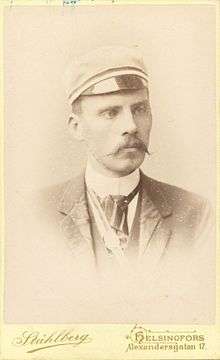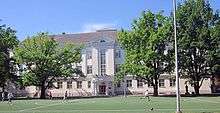Miina Härma Gymnasium
Miina Härma Gymnasium (Estonian: Miina Härma Gümnaasium; abbreviated as MHG) is an institution composed of a primary school and a secondary school in Tartu, Estonia. The school holds a special emphasis on languages. Miina Härma Gymnasium is an IB World School offering the Diploma Programme and the Primary Years Programme, and a candidate school for the Middle Years Programme.[1]

| Miina Härma Gymnasium Miina Härma Gümnaasium | |
|---|---|
 | |
| Address | |
Jaan Tõnissoni 3 , , 50409 | |
| Coordinates | 58°22′36″N 26°42′32″E |
| Information | |
| School type | State-funded secondary school |
| Established | 1906 |
| Founder | ENKS |
| Status | Open |
| Director | Ene Tannberg |
| Grades | 1-12 |
| Language | Estonian, English |
| Newspaper | Tabula Rasa |
| Website | mhg |
History
After the Estonian national awakening had ended the Estonian people were still left under the supremacy of German language and culture. This meant that the upper class mostly spoke German. The first generation of Estonian intellectuals, who were mostly men, did not stop using Estonian language but they married German women. This meant that the domestic language was usually German, which lead to their offspring preferring it to Estonian.
At the beginning of the 20th century Estonian intellectuals such as Jakob Hurt, Oskar Kallas, Jaan Tõnisson and many others decided to tackle the problem by founding a secondary school for girls. In order to obtain a permission to do that an association had to be started. This association was established in the year 1906 and was the Estonian Youth Education Association (Estonian: Eesti Noorsoo Kasvatuse Selts; abbreviated as ENKS). The opening ceremony of the school was held on 1 September 1906 by the Julian calendar and it was named Estonian Youth Education Association's secondary school for girls. Its first director was Oskar Kallas.[1]
School building
Despite having the plan to build its own school house from the start Miina Härma Gymnasium spent its early years moving from place to place. It was caused by the unanticipated costs of building a suitable school house and political conflicts. A contest was run in Finland to design a suitable building for the school, but the winning design turned out to be too costly. Thus, it was adjusted by the engineers Aleksander Raudsepp and Fromhold Kangro to fit the budget of financiers.
The cornerstone of the school house was installed on 1 June 1914. A year later the school building was complete, but the school was unable to move in due to the beginning of World War I. Instead of letting the school to move in, the authorities decided to place there the Austrian prisoners of war. In the year 1917 it was occupied by a military hospital. A year later the German military took possession of the building. Shortly after the communists did the same. It was only in the year of 1921 that the school was finally able to move into its designated building.
Since the school operated several years without a building of its own, it had to rent rooms in a number of places. The first year was spent in 24 Jaani St. after which they moved to 74 Tiigi St. In spite of the unfavorable conditions for studying the school operated there until the year 1915. The school was moved out of there in hope of finally moving into its newly built schoolhouse. Unfortunately, they could not do that. The school found shelter at the commercial school of 6 Fortuuna St., the business school of H. Margens and 12 Holmi St. In the year 1919 the whole school moved to the building of Hugo Treffner Gymnasium in Rüütli St. Finally, in the year 1921 they succeeded in moving into their own school building.[1]
Curriculum
Miina Härma Gymnasium serves students from form 1 to 12. Students can enter based on an entrance exam, which is taken in the spring of each year. Students who have reached the final round in a national olympiad are not required to take the entrance test.
Although the school has aptitude for languages, it still lets students pick from four departments: social, humanities, life sciences and IB programme. The choice of departments starts to matter from the 11th form. In addition the school provides a wide variety of extracurricular activities such as choir and folk dancing.[2][3]
International Studies
Together with the Ministry of Education and Research and Tartu City Government, Miina Härma Gymnasium is preparing to implement the continuum of International Baccalaureate programmes (Primary Years, Middle Years and Diploma) to serve the educational needs of children who temporarily visit Tartu and neighbouring counties due to their parents' mobility. Implementing the IBO programmes takes a couple of years of preparatory work, at the end of which the school is officially authorised by the IBO.
Miina Härma Gymnasium has gained authorisation to teach the Diploma Programme (for students aged 16–19) and the Primary Years Programme (for students aged 7–11). It is in the candidacy phase for the Middle Years Programme, estimated time of authorisation is in 2018. In the academic year 2016/17, MYP grades 1-2 are opened, in the academic year MYP grades 3-4 follow. No tuition fee is charged in the IB Programmes, in the candidacy phase the implementation of the IB pedagogy is in process.[4]
Newspaper
Throughout the years Miina Härma Gymnasium has had several different newspapers. The first was published from 1929 to 1940 and was named “karuohakas” after Hans Karu, the school's headmaster during that period. It spoke of the life in school, country's history and students’ creative works. In the year 1996 the newspaper “Härmakakk” was published.
The current newspaper Tabula Rasa came to be in the year 1998. It means clean slate in Latin. The first publication won the prize of the best school newspaper in Estonia. In the following years it has also won many other prizes.[5]
Notable alumni
- Margarita Voites (Born 1936), coloratura soprano
- Lehte Hainsalu (Born 1938), writer and politician
- Igor Gräzin (Born 1952), legal scientist, lawyer and politician
- Jaak Aaviksoo (Born 1954), physicist and politician, since August 31, 2015 rector of Tallinn University of Technology
- Jassi Zahharov (Born 1954), opera singer
- Urmas Siigur (Born 1956), doctor, medical scientist, chairman of the board of Tartu University Clinic
- Alar Karis (Born 1958), molecular geneticist and Developmental biologist
- Peep Pree (Born 1958), plastic surgeon
- Jürgen Ligi (Born 1959), politician
- Aleksei Lotman (Born 1960), biologist and politician
- Enriko Talvistu (Born 1961), art historian
- Arvo Leibur (Born 1964), violinist
- Rain Simmul (Born 1965), theater and film actor
- Tiit Pruuli (Born 1965), entrepreneur and journalist
- Priit Pullerits (Born 1965), journalist
- Tanel Joamets (Born 1968), pianist and teacher
- Jaan Kirsipuu (Born 1969), cyclist
- Eiki Berg (Born 1970), political scientist, professor of international relations theory in University of Tartu
- Indrek Park (Born 1971), linguist studying North American Indian
- Asko Künnap (Born 1971), designer, poet and head of advertising agency
- Olaf Suuder (Born 1972), television and radio journalist
- Helena Merzin (Born 1972), actress
- Meelis Friedenthal (Born 1973), writer and politician
- Kaupo Karelson (Born 1974), television producer
- Tauno Aints (Born 1975), composer and music teacher
- Tristan Priimägi (Born 1976), film critic
- Krister Paris (Born 1977), journalist
- Carri Ginter (1978), specialist in the field of justice, attorney at law firm Sorainen
- Priit Alamäe (Born 1978), entrepreneur, Nortal founder and CEO
- Sten Tamkivi (Born 1978), entrepreneur in the field of information technology, previous manager of Skype
- Kajar Kase (Born 1980), journalist
- Rasmus Kaljujärv (Born 1981), actor
- Andres Ševtšuk (Born 1981), professor of Urban Planning at the Harvard Graduate School of Design
- Taavet Hinrikus (Born 1981), TransferWise co-founder and one of the owners
- Andra Siibak (Born 1981), Programme Director of Faculty of Social Sciences and Education in University of Tartu
- Riin Tamm (Born 1981), geneticist and Science populariser
- Leopold Parts (Born 1982), geneticist
- Sass Henno (Born 1982), writer
- Rasmus Kull (Born 1984), opera singer
- Kaisa Oja (Born 1984), ballroom dancer
- Mihkel Uiboleht (Born 1987), head of PR at the Estonian Football Association
- Laura Põldvere (Born 1988), singer
- Anna Gavronski (Born 1989), journalist
- Juhan Mettis (Born 1990), judoka
- Sander Pärn (Born 1992), rally drivers
- Tõnis Leht (Graduated 1998), policy advisor, director, producer
- Martin Šmutov (Graduated 2000), head editor of the newspaper Õhtuleht
- Simon Breede (Graduated 2001), opera singer
References
- Tannberg (2006). Sajandi Kool. Tartu: Miina Härma Gymnasium. ISBN 978-9949-13-693-3.
- janar.haidak. "Curriculum". mhg.tartu.ee (in Estonian). Retrieved 2017-06-13.
- janar.haidak. "Miina Härma Gümnaasiumi 10. klassi vastuvõtt". mhg.tartu.ee (in Estonian). Retrieved 2017-06-13.
- janar.haidak. "International Studies". mhg.tartu.ee (in Estonian). Retrieved 2017-06-13.
- Administrator. "Kooli leht Tabula Rasa". mhg.tartu.ee (in Estonian). Retrieved 2017-06-13.